
It is the ancient prerogative of human beings to divine constellations. Out of the infinite waves of light emanating from stars billions of light years away, we will discern patterns, and from patterns fashion stories, and from stories find meaning. And Teen Vogue will offer weekly interpretations in case we’re too dense to understand the universe’s message.
On the latest episode of
, we interviewed the visual artist Emilee VerDuin, of illustration, who among other things is an American ex-patriate living in Bulgaria. I recommend the whole interview because she’s a fascinating artist, but towards the end of the conversation she mentioned that she’s tired of living in the apocalypse. She whimsically listed off a few recent apocalypses (apocali?): A.I., aliens, crypto, elections, and then concluded that they simply aren’t going to happen like all of the arm-chair Nostradamuses had predicted.I suspect that one of the reasons that she feels it so strongly is because of her recent move to rural Bulgaria. She’s swimming against the current, away from America, away from cultural centers, into a community of senior citizens that have watched all their young people move to cities and other countries with more economic opportunity. “They’ve already had their own apocalypse,” Emily says. And now she’s moved into a post-apocalyptic community where all of the symbols and nodes of meaning have been steadily deconstructed for a century through socialism and then the fall of socialism. And suddenly because she’s been grafted into an old community, all of the urgent fears in which her old American community were stewing have evaporated. Were they ever real? Were those lines we drew between points of light in the night sky really the stories of gods at work, or were they only our vain attempts to make meaning out of chaos; the exposure of our greatest fears?
My hypothesis is that we are always, moment-by-moment, living in an apocalypse. The word itself, removed of all its end-of-the-world portent, simply means a revealing. It’s the antonym for eclipse. We usually translate it as revelation. John the Revelator wrote his Apokalypsis of Jesus Christ. The Book of Revelation.
So if we’re moment-by-moment experiencing a revelation about ourselves, what is being revealed? My guess is both our greatest fear and our greatest affection. For the readers of John’s vision, Jesus Christ is one of those two things. Or maybe, Christ is both things for everyone, because running down the middle of everyone’s soul is the fear of divine judgment (God knows what I’ve done in the secret darkness of my heart) and the affection for divine mercy (only God can untangle my knot of vipers and he loves me enough to do it).1
At least that’s the case if you’re one of John’s intended audience. If not, you probably read it as a weird story that religious fanatics try to decode like a true-crime podcast.
For people who don’t take the Book of Revelation seriously, don’t despair, you’re experiencing your own apocalypse. Cultures and sub-cultures are a vast network of meaning, or perhaps a constellation of symbols. Here are two recent examples.
The Dallas Mavericks traded Luka Dončić to the Los Angeles Lakers. Sports news devoted 24-hour commentary commemorating Luka’s career highlights, and the Internet was full of bulletin-board analysts pinning string theories between Luka’s conditioning, his loyalty to the city of Dallas, the identity of Dallasites as their sports franchises are betraying them, the lobby to legalize casinos in Texas, the devaluing of the Mavericks in order to justify an eventual move to Las Vegas and on and on. One of my adult family members lost sleep over this. It was a religious apocalypse wherein the greatest affection collapsed and the greatest fear was realized. Is that silly? If you aren’t a Mavs fan, it seems silly. I was outside of that constellation, so it wasn’t painful for me; although I could see that people were experiencing deep sadness. Was it real?
Another example: Kendrick Lamar performed at the half-time show. Again, people who are exhaustively abreast of Kendrick’s career appeared out of the debauchery as if Kendrick had rapped “mene mene tekel upharsin.” A line was drawn between every dance move, every background outfit change, every song lyric, black history in America, every reference to Drake, every reference to Drake’s ex-girlfriends. And the interpreters were utterly serious. And Drake was thrown down into the lake of fire and sulfur where the beast and the false prophet were. People treated the performance as if it were the great revelation of black culture in America, its culmination, the demonstration of its dominance.
Many other people were also mad at him because they didn’t understand it. I read several takes reacting to the reactions of people who didn’t like it. Someone points to racism, another to DEI2. Why it can’t simply be an aesthetic preference is beyond me. But I suspect that it’s really this: We’ve aged out of the target demographic of prime consumerism (18-35 years old) that is the Super Bowl. We don’t understand what’s being sold because it’s not being sold to us and therefore, we’re not useful to that machine despite having spent our prime years in prayerful devotion to it. Was it our greatest affections being consummated or our greatest fears being exposed?
Either way, the cultural obsession with it certainly tells us something about ourselves.
I have a friend from high school. He’s moved to the San Francisco Bay area and works for a massive tech corporation producing advertising that winds up in Super Bowls and Las Vegas spheres. He comes back to our hometown about once every five years and we split a six pack and have what I take to be pleasant conversations reminiscing about the years of our formation. But each time Trump is elected, he sends me DMs (even though he has my phone number) cursing me for being part of a religion that elected Trump. I’m always confused by these messages, but the severity of his accusations seem apocalyptic. Upon which stars is he drawing his constellations? If I lived in San Francisco and chased the things San Franciscans are encouraged to chase, I’d probably be mad at me too.
The opening image of Kevin Costner’s Horizon: An American Saga is the stake of a surveyor’s theodolite being plunged into an ant bed. Pretty on the nose. The surveyors are quickly dispatched by Apaches. A Spaniard comes along and buries them under three crosses, and the town of Horizon is founded across the river from their graves. Also pretty on the nose.
No matter which sub-culture we find ourselves to be a member of, there is built into the constellation of that culture’s imagination an apocalyptic end. It used to be nuclear war, but then the Cold War ended. It used to be some sort of plague, usually zombies, but then we had a plague. Those ends, although real, turned out to be less catastrophic than anticipated. The Book of Revelation is remarkable because its the apocalypse of apocalypses. It takes the stories of Israelite culture, which had ended time after time—Egypt, Civil War, Assyria, Babylon, Persia, Rome—like an ant bed and showed how the provident hand of their God had regathered and rebuilt them and promises a city in which death is not a factor. John’s apocalyptic vision is the culmination of all the Israelite, and many of the surrounding pagan cultures’ greatest fears and affections. And it turns out, those ancient fears and affections plague our modern hearts in the same way.
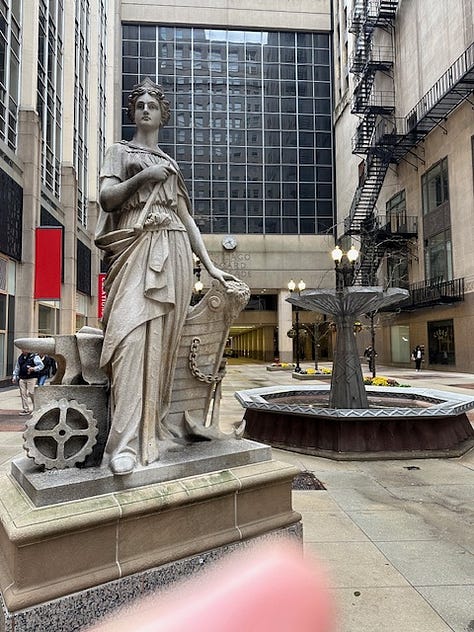
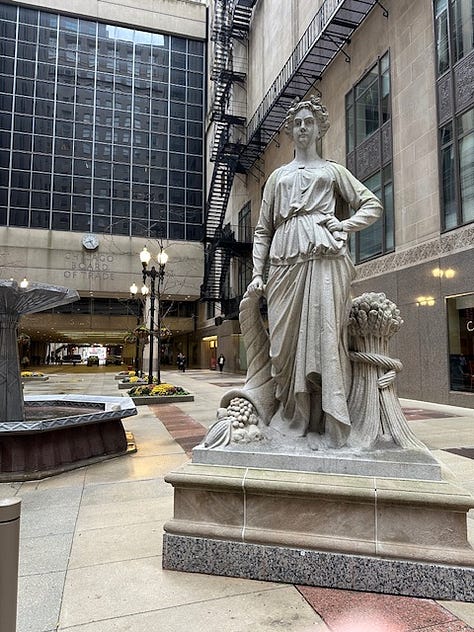
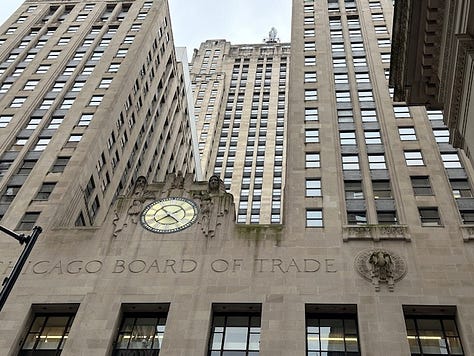
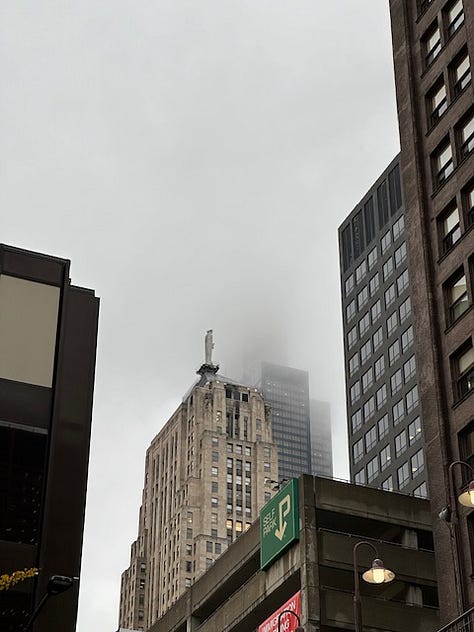
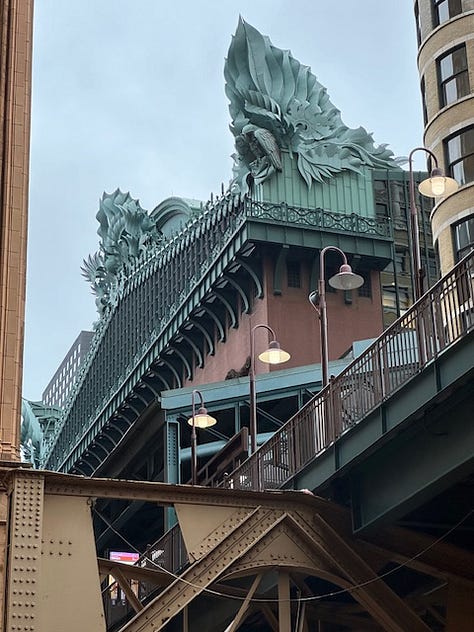
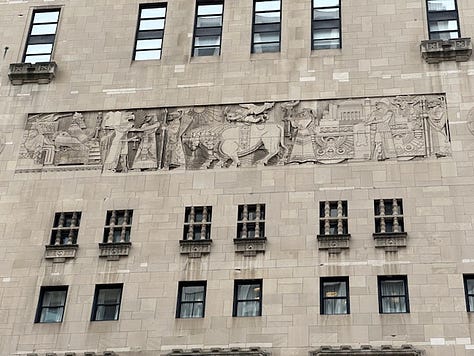
Various ancient pagan gods depicted in the architecture of Chicago. My wife and I visited Chicago in November. I couldn’t help but notice the various ancient pagan gods depicted in the architecture of Chicago. The matron goddess of Chicago is surely Ceres, the Roman goddess of the harvest and grain, from whom we get our word cereal. You can find her depicted all over the city, but especially atop the Chicago Board of Trade within whose Olympian walls the price of agricultural commodities is determined. Rome as we know had its own apocalypse.
Elsewhere on the Inter-Continental hotel, three of the facades have friezes of Assyrian gods. The frieze above is entitled “Consecration” in which a bull is being sacrificed, its blood mixed with wine and poured onto the ground, before a bird-headed deity. Most of the descriptions I found of the building describe the friezes almost as pastiches—unserious throwbacks to ancient civilizations—but the hard-partying Shriners, who built the building for Dionysian, Gatsby-style ragers, were just frat-boy Masons who loved their ancient pagan rites. Assyria had its apocalypse, as did Babylon, as did Persia, and so has Chicago a few times. It’s hard not to imagine the impressive new glass and steel towers along the river as mock Babels.
Are the objects of our fears and affections real? At some point the Aegeans do park a wooden horse outside the gates of Troy. The Babylonians drag off the brightest Hebrews. The Romans plunder the temple. The Nazis load the cattle cars. At some point, the leader does turn out to be the psychopathic despot, and the constellations collapse and the stars fall from the heavens as unripe figs are shaken from a tree in a storm.
Does the object of our affection provide us with enough to build again? Does it love us back? Or was it a flimsy patch, sold as a package deal with our fears?
See my friend Jack’s paintings of Revelation 19 as well as Zechariah’s divine court room to get a sense of both.
I’m skeptical about this. On the other side of things, I heard a Ph.D I used to read interpreting Carrie Underwood’s performing at the Inauguration as coded racism a few weeks before the Super Bowl. To the hammer, everything looks like a nail.




I’ve been thinking a lot about the possibility of “changing the dream”, as Emilee discussed with you guys. I really love this ending question of yours, does our affection provide enough to build back with…
Damn. Hit straight to the heart for me these last few weeks. I was reading Marc Auge’s Non-Places: An Introduction to Supermodernity last night and was taken by his reflection on the work of anthropologists and historians, where they align and diverge and how most are struggling—and have been since the 80s around the time the book was written—to contend with their perceptions of the increasing immanence of time creeping up on us. With technology at work, everything quickens and everything “feels” like an apocalypse even when few may actually be truly apocalyptic.